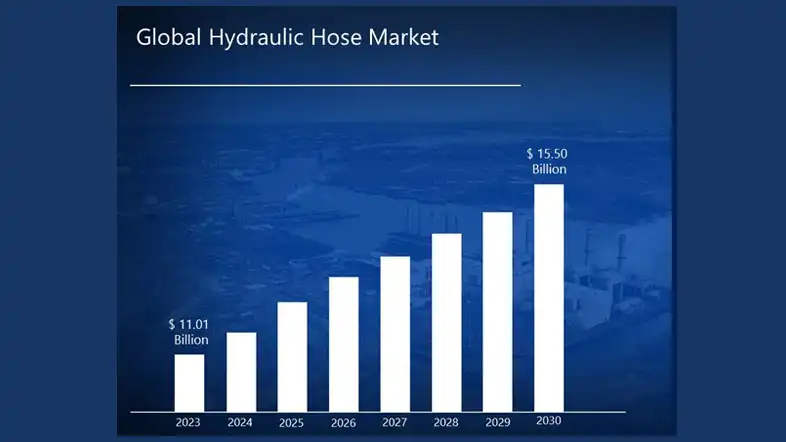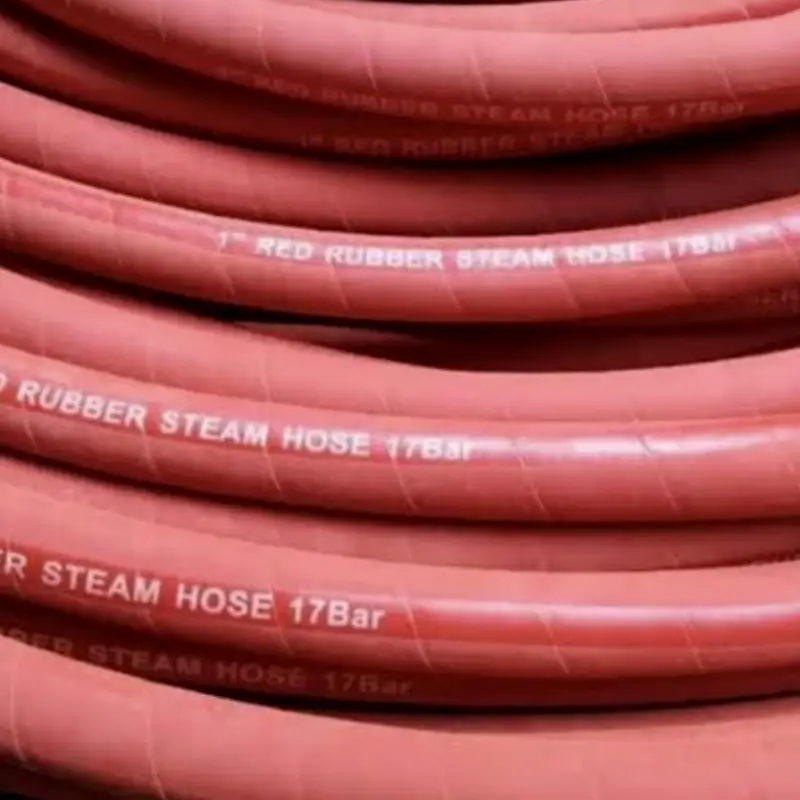The hydraulic hose market has been witnessing a steady growth trajectory, driven by the rising demand for equipment and machinery across various industries.
Hydraulic hoses play a critical role in transmitting hydraulic power to efficiently operate machinery, making them an indispensable component in a wide range of applications.
In this blog post, we will delve into the dynamics of the hydraulic hose market, exploring key factors driving its growth, trends shaping the industry, and future opportunities.
Factors Affecting the Hydraulic Hose Market

Understanding the factors affecting the hydraulic hose market is essential for businesses, investors, and manufacturers. Market growth is influenced by technological advancements, demand from industrial and construction sectors, regulatory standards, and the adoption of advanced materials. Identifying these factors helps companies make informed decisions and remain competitive in a dynamic industry.
Technological Advancements
Technological developments in hose materials, reinforcement methods, and manufacturing processes directly influence the hydraulic hose market. Innovations such as smart hoses, improved composites, and enhanced pressure resistance increase product efficiency, durability, and safety, driving market growth and opening opportunities for advanced industrial and automotive applications.
Industrial and Construction Demand
The demand for hydraulic hoses in industrial machinery and construction equipment is a key market driver. Growing infrastructure projects, automation, and mechanization require reliable fluid transfer solutions, increasing sales and expanding market opportunities for high-performance hydraulic hoses in these sectors.
Regulatory Standards and Compliance
Government regulations and safety standards affect the production, testing, and usage of hydraulic hoses. Compliance with environmental, pressure, and quality standards ensures reliability and safety, influencing manufacturers to adopt best practices, which impacts market trends and supplier selection.
Material Innovations
Advances in materials such as synthetic rubber, thermoplastics, and reinforced composites enhance hose performance. By offering better temperature, pressure, and chemical resistance, material innovations allow hydraulic hoses to meet diverse application needs, driving adoption and expanding market opportunities globally.
Global Economic Conditions
Economic trends, including industrial growth, construction activity, and investment levels, impact market demand. Fluctuations in economic conditions influence infrastructure projects, machinery sales, and industrial expansion, shaping the growth trajectory of the hydraulic hose market worldwide.
How to Research the Hydraulic Hose Market

Researching the hydraulic hose market is crucial for understanding industry trends, customer needs, and competitive dynamics. By conducting thorough market research, businesses can identify growth opportunities, assess risks, and make informed decisions about product development, supply chain management, and strategic investments in the hydraulic hose sector.
- Analyze Market Trends: We examine industry reports, sales data, and emerging technologies to identify key trends in the hydraulic hose market. By understanding market directions, we help businesses anticipate customer needs, adapt to technological advancements, and position their products competitively.
- Identify Target Customers: We research customer segments, applications, and buying behaviors to determine market demand. By profiling end-users such as industrial, automotive, and construction clients, we provide insights that guide marketing, product design, and sales strategies for maximum impact.
- Evaluate Competitors: We analyze competitors’ product offerings, pricing, and market positioning. By assessing strengths and weaknesses, we help businesses identify opportunities for differentiation, improve value propositions, and create strategies to gain a competitive advantage in the hydraulic hose industry.
- Assess Supply Chain and Distribution: We study suppliers, distributors, and logistics channels. By understanding supply chain dynamics and identifying reliable partners, businesses can ensure consistent product availability, reduce costs, and maintain operational efficiency while meeting market demand.
- Monitor Regulatory and Environmental Factors: We track regulations, safety standards, and environmental policies affecting the hydraulic hose market. By staying compliant and adapting products accordingly, businesses can avoid penalties, enhance product credibility, and maintain a positive reputation in the industry.
How to Start Hydraulic Hose Business

Starting a hydraulic hose business involves several key steps. Here’s a detailed guide on how to get started:
Market Research:
- Analyze the current market trends, demand, and competition in the hydraulic hose industry.
- Identify the target market segments, such as construction, agriculture, manufacturing, or automotive.
- Understand the specific requirements, standards, and regulations within your target market.
Business Plan Development:
- Outline your business objectives, product offerings, and strategies.
- Conduct a feasibility analysis to assess the viability of your business idea.
- Develop a comprehensive business plan that includes financial projections, marketing strategies, and operational details.
Regulatory Compliance:
- Familiarize yourself with the relevant industry regulations, safety standards, and certifications.
- Obtain the necessary business licenses, permits, and registrations required to operate in your jurisdiction.
- Ensure compliance with environmental regulations and workplace safety guidelines.
Hydraulic Hose Manufacturer and Inventory Management:
- Identify reliable suppliers of high-quality raw materials, such as rubber, polymers, and metal fittings.
- Establish efficient inventory management systems to maintain optimal stock levels and minimize costs.
- Develop strong relationships with suppliers to ensure a stable and reliable supply chain.
Manufacturing and Production:
- Invest in the necessary equipment and machinery for hydraulic hose manufacturing, such as extrusion machines, braiding machines, and cutting tools.
- To find a reliable hydraulic hose manufacturer to provide you with a qualified hydraulic hose wholesale.
- Implement quality control measures and testing procedures to ensure the reliability and performance of your hydraulic hoses.
- Explore opportunities for automation and lean manufacturing techniques to improve efficiency.
Distribution and Sales:
- Establish a distribution network, which may include wholesalers, distributors, or direct-to-customer sales.
- Develop a robust marketing strategy to promote your hydraulic hose products and services.
- Leverage various sales channels, such as online platforms, trade shows, and direct sales to reach your target customers.
Customer Service and Technical Support:
- Provide comprehensive technical support and after-sales services to your customers.
- Offer guidance on hose selection, installation, and maintenance to build long-term relationships.
- Respond promptly to customer inquiries and address any issues or concerns efficiently.
Financial Management and Funding:
- Secure the necessary funding, whether through personal investments, loans, or venture capital.
- Implement sound financial management practices, including budgeting, cost control, and financial reporting.
- Explore opportunities for government incentives or subsidies that may be available in your region.
Starting a hydraulic hose business requires a combination of industry knowledge, strategic planning, and effective execution. By carefully addressing each of these steps, you can establish a successful and sustainable hydraulic hose business in the market.
Conclusion
The hydraulic hose market is poised for significant growth in 2025, driven by advancements in materials, technology, and increasing demand across industrial, automotive, and construction sectors. Businesses that stay informed about market trends and emerging opportunities can position themselves for long-term success and profitability. For reliable product supply, get wholesale hydraulic hoses from Kingdaflex to meet growing operational needs.
Understanding market drivers, such as industrial automation, regulatory compliance, and material innovations, is essential for manufacturers and buyers alike. By adapting to evolving demands and investing in high-quality solutions, companies can maintain a competitive edge while ensuring efficiency, safety, and durability in their hydraulic systems. Kingdaflex provides top-grade hoses that support these requirements.
In conclusion, the hydraulic hose market offers substantial opportunities for growth and expansion. By leveraging industry insights, focusing on quality, and sourcing from trusted suppliers, businesses can maximize performance and profitability. Secure your supply today by getting wholesale hydraulic hoses from Kingdaflex and stay ahead in the market.




